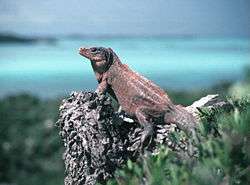Acklins ground iguana
| Acklins ground iguana | |
|---|---|
 | |
| Scientific classification | |
| Kingdom: | Animalia |
| Phylum: | Chordata |
| Class: | Reptilia |
| Order: | Squamata |
| Suborder: | Iguania |
| Family: | Iguanidae |
| Genus: | Cyclura |
| Species: | C. rileyi |
| Subspecies: | C. r. nuchalis |
| Trinomial name | |
| Cyclura rileyi nuchalis Barbour and Noble, 1916 | |
Cyclura rileyi nuchalis, commonly known as the Acklins ground iguana or Watling Island iguana, is an endangered subspecies of lizard of the genus Cyclura it is one of three subspecific forms of Cyclura rileyi in the family Iguanidae.[1]
Taxonomy
The Acklins ground iguana is a recognized subspecies of the San Salvador Rock Iguana, recognized as such since 1975.[1][2] The species is listed as endangered according to the current IUCN Red List.[1]
Its generic name (Cyclura) is derived from the Ancient Greek cyclos (κύκλος) meaning "circular" and ourá (οὐρά) meaning "tail", after the thick-ringed tail characteristic of all Cyclura iguanas.[3] Its specific name, rileyi, is a Latinized form of the name of American biologist, Joseph Harvey Riley.[4] Its subspecific name,nuchalis, is Latin for "neck" in reference to the thick scalation around the animal's neck.
Anatomy and morphology
The Acklins ground iguana strongly resembles the San Salvador rock iguana in color and shape. The lizard's back color can range from red, orange or yellow, to green, brown or grey, usually patterned by darker markings. The very brightest colors (red, orange or yellow) are normally only displayed by males and are more pronounced which at warmer body temperatures. Immature iguanas lack these bright colors, being either solid brown or grey with faint slightly darker stripes.[1] What makes this iguana stand out from the other two subspecies is the scalation on its neck and head.
This subspecies, like other members of Cyclura, is sexually dimorphic; males are larger than females, and have more prominent dorsal crests as well as larger femoral pores on their thighs, which are used to release pheromones.[5][6]
Distribution
The Acklins ground iguana is endemic to three small cays in the Bahamas and is described as endangered according to the current IUCN Red List.[1]
Natural populations of Acklins ground iguanas are found only on Fish Cay and North Cay in the Acklins Bight, Bahamas.[1][7] They formerly inhabited Long (Fortune) Cay.[1] An additional introduced population with five founding individuals was established on a small cay in the early 1970s.[1][7][8]
These two populations are made up of 12,500-18,800 individual animals.[7] A translocated population in the Exumas Land and Sea Park contains 300 animals and appears to be stable.[7]
Diet
Like all Cyclura species the Acklins ground iguana is primarily herbivorous, 95% of which from consuming leaves, flowers and fruits from 7 different plant species such as seaside rock shrub (Rachicallis americana), and erect prickly pear (Opuntia stricta). This diet is very rarely supplemented with animal matter, although a wild specimen has been recorded eating mice.[7]
Mating
Mating occurs between May and June depending on when the dry season ends, and 2-5 eggs are usually laid within 40 days depending on the size and age of the female.[8] Some females have been observed migrating to coastal areas on the various cays in order to build their nests in the sand, and some guard the nest site for a short period of time.[8] The hatchlings emerge from the nests in August to early September.[1]
Habitat
Unlike every other species of Cyclura the Acklins ground iguana is free of threats by feral predators.[7] The cays they dwell on are remote and human populations leave the animals undisturbed.[7] Natural predators in the form of ospreys, herons, kestrels and seagulls have minimal impact on the populations.[7]
The Acklins Cays also have an abundance of food and vegetation compared to the cays on which other iguanas are found and this also must be considered as a factor in their success.[7] Sea level rise may be the greatest threat these animals face in the future, as the cays lack elevation relief and a sea level rise of 1 meter over the next 100 years could cost the cays up to 50% habitat loss.[7]
References
- 1 2 3 4 5 6 7 8 9 10 Carter, R.L.; Hayes, W.K. & West Indian Iguana Specialist Group (2000). "Cyclura rileyi nuchalis". IUCN Red List of Threatened Species. Version 2013.2. International Union for Conservation of Nature. Retrieved 15 March 2014.
- ↑ Hollingsworth, Bradford D. (2004), "The Evolution of Iguanas: An Overview of Relationships and a Checklist od Species", Iguanas: Biology and Conservation, University of California Press, pp. 35–39, ISBN 978-0-520-23854-1
- ↑ Sanchez, Alejandro. "Family Iguanidae: Iguanas and Their Kin". Father Sanchez's Web Site of West Indian Natural History Diapsids I: Introduction; Lizards. Kingsnake.com. Retrieved November 26, 2007.
- ↑ "Riley, Joseph - Biography", Washington Biologists' Field Club, Patuxent Wildlife Research Center
- ↑ De Vosjoli, Phillipe; David Blair (1992), The Green Iguana Manual, Escondido, California: Advanced Vivarium Systems, ISBN 1-882770-18-8
- ↑ Martins, Emilia P.; Lacy, Kathryn (2004), "Behavior and Ecology of Rock Iguanas,I: Evidence for an Appeasement Display", Iguanas: Biology and Conservation, University of California Press, pp. 98–108, ISBN 978-0-520-23854-1
- 1 2 3 4 5 6 7 8 9 10 Hayes, William; Carter, Ronald; Cyril, Samuel; Thornton, Benjamin (2004), "Conservation of an Endangered Bahamian Rock Iguana, I", Iguanas: Biology and Conservation, University of California Press, pp. 232–243, ISBN 978-0-520-23854-1
- 1 2 3 Thornton, Benjamin (June 2000), Nesting Ecology of the Endangered Acklins Bight Rock Iguana, Cyclura Rileyi Nuchalis, In The Bahamas, abstract, Andrews University.
